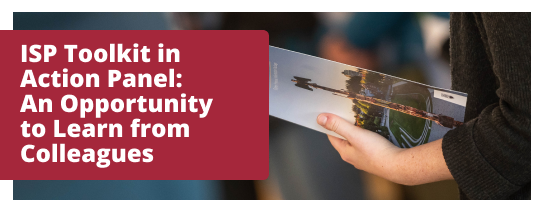Written by: Andrea Barragán Rivero, Paulina Semenec, Carissa Block, Janelle Kasperski
On October 24th the Office of Indigenous Strategic Initiatives (OISI) and the Indigenous Initiatives (II) Team at CTLT hosted the ISP Toolkit in Action Panel: An Opportunity to Learn from Colleagues. The Indigenous Strategic Plan (ISP) Toolkit was developed by OISI to help both academic and operational units create a plan that aligns their work with the ISP’s eight goals and 43 actions. Four panelists were invited: Emma Davy (Chemistry UBC-V), Jannik Eikenaar (Engineering UBC-O), Annabel Lyon (Creative Writing UBC-V) and Nicole Balsdon (Beaty Biodiversity Museum UBC-V). The event was moderated by Janelle Kasperski, an educational consultant from the Indigenous Initiatives team. Throughout the panel we saw that each unit represented identified similar learnings even if their pathway to those learnings may have been different. We hope that hearing their experiences may help others who are at various stages in their ISP engagement across UBC.
The session began with a question that may resonate with many folks who are new to the ISP – how panelists got started in this work. One panelist shared that they were part of an existing committee dedicated to advancing Indigenous initiatives within their unit where it was determined that that group would take on the work. Another panelist shared that they began their process by meaningfully connecting with Indigenous colleagues in their unit to gauge their interest in participating, and to learn in what ways they would or would not enjoy being part of the process. Then, they did a call-out to the whole unit to create a committee of about ten people, ensuring that faculty and staff roles were represented, particularly staff roles that intersected with students. A common thread for the panelists was the importance of acknowledging and talking about the power dynamics at play and how to move forward together in a good way.
Each of the panelists also shared some advice on how to manage the logistical challenges when working collaboratively with a large group of people. Because the initial stage of the ISP Toolkit – the ISP Self-Assessment Tool – involves a series of reflection questions intended to be discussed with a group of up to 15 people, some groups opted to send out a survey of the self-reflection questions to their entire unit prior to gathering. They found that giving folks the time to think about the questions in advance of meeting allowed them to bring in feedback from the entire unit into their conversations. In another effort to manage people’s busy schedules, some folks also decided to gather online while others attended meetings in person. While both formats worked well, those who gathered in person noted that sharing food was impactful and important for the success of the conversations.
In terms of how groups got organized, it was shared that one of the units created a Canvas page as a centralized space where members of the committee could engage asynchronously, and the wider unit could keep up to date on what work was being done. This was especially helpful when it came to reflecting on the pre-reading that is recommended at the beginning of the ISP Self-Assessment Tool. Each member of the group volunteered to guide the others through the various sections of the pre-reading across a number of months. Others on the panel highlighted the importance of keeping meeting notes and having a centralized space to share all documents and resources, whether that be within MS Team, Canvas or other platforms. They mentioned how this helped them hold themselves accountable, ensure transparency and keep track of the progress the unit was making. As the panelists made clear in their introductions, ISP Toolkit engagement is a process that should not be taken lightly. It is hard, and often uncomfortable work, and should be recognized as part of people’s jobs, not as a volunteer side project.
One of the questions the panelists were asked to respond to was; “What are some lessons you learned along the way?”. One person acknowledged the risk of being a single person tasked with holding the bulk of the work. They explained that the ISP engagement needs to extend beyond the responsibility and institutional knowledge base of one person and that as a collective effort, it should be embedded across the unit to be sustained and successful. Several of the panelists mentioned that they received some support from outside their unit, at least in the initial planning stages. They spoke about how it was helpful to receive guidance from others with previous engagement experience including: the Skylight Science Centre for Teaching and Learning, the Indigenous Initiatives team at CTLT, and as well as support from Indigenous Programs and Services at UBCO. Some of the advice they received included how to engage in difficult conversations and feedback on their facilitation plans. Additionally, as the Q&A part of the session further reiterated, when leadership engages with the ISP, they open up a space in their unit or faculty and set the tone for future work, making it easier for further engagement or new leaders or managers to continue that work.
In closing, the moderator reminded participants that the process may look different for every unit – that there is no one size fits all model. She advised folks to take what resonates in the process and leave what does not, and that while we might take different paths, we are all working towards a shared goal of decolonizing and Indigenizing higher education institutions. She encouraged everyone to make adjustments, consult on the process, and continuously check in with each other and their colleagues on how they feel in the journey. And lastly, she encouraged us all to trust that we are where we should be, and that things will happen as they are supposed to.
We encourage anyone who is new to ISP engagement to visit the ISP Toolkit website.
